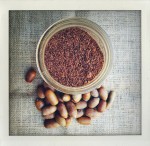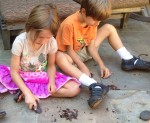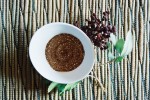Tasting the Wild Food Forest in Fall-Oak Nuts, Pine Nuts & Madrone
Growing, collecting and cooking with wild food allows us to cultivate a sense of place—a deep awareness of the land we call home. Learn how to collect and prepare wild foods this fall, including discovering the simplest way to turn oak nuts (acorns) into flour. Find out about how to use Rose Hips, California Bay, and antioxidant-rich Toyon and Madrone berries to create nutritious, native-food recipes.
Here are a few of my favorite fall ingredients–
Oak Nuts
Oak nut flour is gluten-free and adds a good source of nutrition to any recipe, with higher amounts of essential fatty acids, folate, potassium, Vitamin A and calcium compared to wheat flour. It is denser than wheat flour and combines well with other types of gluten-free flour.
Leaching Acorns to Prepare Oak Nut Flour
Seasoning Acorns Just like a fine wine, acorns are
better when aged. According to Maidu Indian knowledge,
acorns should be cured for approximately a year before
leaching. This can be done by keeping them in a dry, well-ventilated
basket and shaking them at least once a month
to rotate the acorns. Curing dries the acorns and allows the
red skins covering the nut to come off easily. The red skins
contain high quantities of bitter tannins so this process also
shortens the leaching time. Heat shelled acorns at 200o for
10 minutes prior to grinding to easily remove the red skins.
Glass jar Method
– Estimated Time: 1 – 2 weeks. This is the simplest
method but takes the longest amount of time.
– Shell acorns using a hammer and remove thin red
skin.
– Grind to a fine powder in food processor.
– Place in a mason jar, cover with water, and label
with the expected completion date.
– Change water daily until clear, tasting for lack of
bitterness.
Note
– After leaching, dry the flour in the sun for several days
or bake at 250 for 30 minutes.
– Grind nuts finely, if using for flour.
– Use immediately, refrigerate or freeze for future use,
as Oak nuts are perishable.
TIP For added flavor and nutrition, try sprouted Oak
nuts. Soak in a glass jar for 2 days, then cover jar with
cheesecloth and rinse twice daily until sprouts begin to
emerge.
Pine Nuts
Shelling Pine Nuts
– Gather cones when tightly closed or when seeds are visible inside slightly open cones. Store in a burlap sack (or pillowcase) in the sun or by a heat source until they open. You can also just let them sit, safe from squirrels, and they will eventually open on their own.
– Remove seeds by shaking the bag or banging the bag against a hard surface.
– Shell seeds by lightly tapping with a hammer or between two rocks. Another
method is to place seeds into a plastic bag, removing any air, and press down
with a rolling pin to crack the nuts.
Pine Nut Fritters
(Vegan, Gluten-Free) Collect nuts in fall.
4 cups cooked couscous
2 cups toasted Pine nuts
1/2 cup steamed and chopped Nettles (or chopped
spinach)
Juice of 1 lemon
1 tsp chopped California Bay leaves
3 garlic cloves
Method
– In blender, puree 1/2 cup of the Pine nuts with
garlic and lemon juice until thick. If needed,
add water or veggie stock a tbsp at a time to
pur.e and make smooth.
– Combine with the chopped spinach, rosemary,
couscous, and season to taste.
– Form into 2 oz cakes and saute in extra virgin olive oil.
Wild Grape Butter
Grape Butter Collect ripe fruit in fall.
Native Grapes (Vitis californica)
Local honey
Method
– Cook berries on low heat in pot for 15 minutes
and crush them when they start to soften.
– Strain through cheesecloth.
– Add an equal amount of local honey to the
berry juice.
– Reheat, stirring often, for about 20 minutes or until
thick and pour into in sterilized jars to can.
Rose Hips
Rose Hip Tea Collect hips in early winter.
2 tbsp fresh or 2 tsp dried Rose hips per cup of water
Method
– Remove stems and ends.
– Cover with water and boil for 20 minutes.
– Strain through a colander into a bowl and set
aside Rose hips.
– Serve hot or cold.
TIP After making tea, add used Rose hips to soups or
serve as a side dish. To dry Rose hips, place a single
layer on a cookie sheet covered with wax paper, and
keep in a dark, ventilated area for several weeks.
Madrone Berries Collect berries in late fall.
FRESH/Dried/FROZEN For best flavor, harvest when bright
red (not orange), often after a frost. Since Madrone trees
are tall when they are mature and producing fruit, collect
berries from the ground or use a long clipper to reach
berries growing on high branches.
Toyon Cider Collect berries in winter.
Method
– Cover dried berries with water.
– Bring to a boil and simmer for 20 – 30 minutes
while crushing berries.
– Strain and sweeten as desired.
TIP Toyon cider has a wonderful aroma and color. Fresh berries can be used, but dried berries are much sweeter.









One comment on “Tasting the Wild Food Forest in Fall-Oak Nuts, Pine Nuts & Madrone”
Comments are closed.